The History of Pattern Weights with Stand
For centuries, dressmakers, tailors, and crafters have relied on pattern weights as essential tools. These weights traditionally held fabric patterns in place during cutting, eliminating the need for pins that could distort or damage delicate materials. Over time, pattern weights evolved in design, with various shapes, sizes, and materials, ranging from simple stones to specialized weights. The introduction of a stand further enhanced their usefulness by keeping workspaces tidy and weights easily accessible.
Practical Uses of Pattern Weights with Stand
Pattern weights with stands play a key role in sewing and crafting. Placing the weights on fabric patterns holds them steady during cutting, ensuring precise and accurate cuts without any shifting. The stand offers a practical storage solution, keeping weights within easy reach and preventing them from getting lost in clutter. This setup is especially helpful when working on multiple projects, allowing for quick and efficient changes between patterns and fabrics.
The Lasting Legacy of Pattern Weights with Stand
Pattern weights with stands embody a legacy of practicality and tradition. With the rise of DIY culture, these tools have become even more popular. Modern pattern weights often feature beautiful designs that combine functionality with aesthetic appeal. The addition of a stand has solidified their role as a staple in well-organized sewing rooms, emphasizing precision and care in the craft. Passed down through generations, these tools maintain a timeless connection to the art of garment-making and fabric design.

Leave a Reply